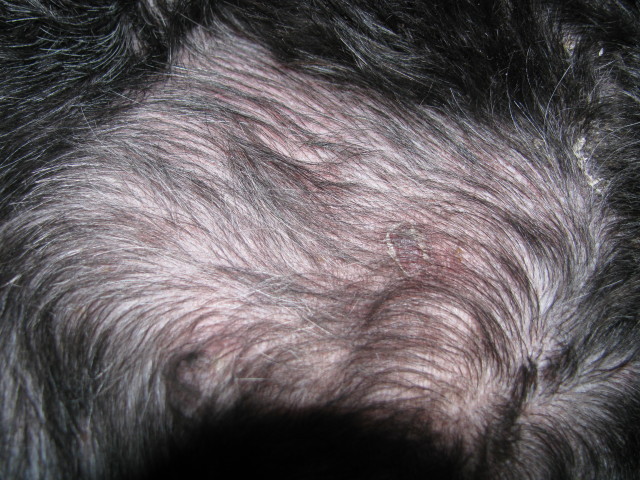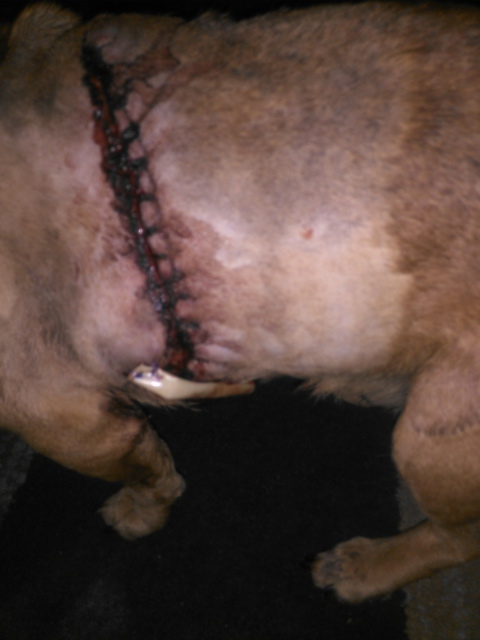QuestionI have an 11 year old dog. He is a 135 lb. golden. His age has brought on weaker legs, brought on I am sure by his immense size. Last weekend he slid down a flight of stairs. He is fine walking and even able to trot. He is unable to get up from a lying position. I have decorated my house w/ runner rugs to avoid him slipping on the tile so he can stand. We have rubbed and squeezed all his legs looking for the root of the problem and tonight while washing him I discovered a tendon perhaps stands out strongly down the back of his hock, difficult to find on his other, I have looked up different ligaments and such and am unable to find what it could be named. I have never denied him the healthcare he needs but circumstances have prevented me to be able to afford rushing him to the vet this week. Please understand, He is not in crucial pain, I was just hoping you could point me in the direction of what it could be and if I should let time heal him or I'm crazy and I should have run him to the vet. It seems to be right where the back of a human knee would be. He now falls frequently on the tile. Thanks for your help. Melissa
AnswerHi Melissa,
It's possible that your dog has a fracture, or a torn ligament. If the injury is about where a human knee would be, then it's a stifle joint injury.
You know your dog best. If you don't think he's suffering, and he's able to get around on his own steam (once he's standing) there's no reason to rush off to the vet. He's not a youngster, it's really your call.
Giving the injured leg plenty of rest, and restricting your dog's activity might help. Don't let him run or trot. Running is more stressful than walking. Small amounts of gentle activity are appropriate, but all forms of excess must be avoided completely.
If he's slipping on the tile floors, can you keep him out of those rooms?
If your dog is crate trained, spending more time in the crate right now would help keep him still.
You can help your dog to a standing position with the use of a towel as a sling. Place the towel under your dog's rib cage, and sort of hoist him into a standing position. It's probably best if your dog avoids the stairs, since he's not as nimble as he used to be. A child gate would help keep him off the stairs.
If your dog tolerates aspirin, you can try that to help reduce swelling and pain (dogs are pretty stoic, about showing pain, but that doesn't mean he's not actually in pain). You can give your dog buffered aspirin. The dose is 10mg/per pound of body weight twice a day. To reduce the risk of stomach irritation give aspirin at mealtime. Don't use Enteric coated, or "safety coated" aspirin. About half the time the coating isn't digested and the aspirin is excreted whole in the stool.
It is extremely important to pay attention to your dog's eating habits when administering aspirin. Dogs have no way to tell you their stomach is upset so you must watch for signs of this. If your dog stops eating while you are giving aspirin it is important to stop giving the aspirin.
I'd give the rest and aspirin about three days. If your dog is still having problems, or if his leg still looks inflamed, then it's time to see your vet.
I hope I've been a help.
Best of luck,
Patti

 7 week old lurcher pup
Question
this is Lady
hi there me and my partner purch
7 week old lurcher pup
Question
this is Lady
hi there me and my partner purch
 puppy behavior
Question
Cooper and Guy
Hi, thanks so much for reading
puppy behavior
Question
Cooper and Guy
Hi, thanks so much for reading
 Dog fur is flaking off, scabbing, itching like crazy
Question
zacks tummy
Hi,
We have a four-year-old cockap
Dog fur is flaking off, scabbing, itching like crazy
Question
zacks tummy
Hi,
We have a four-year-old cockap
 tumor on my dog
Question
stitched up second tim tumor
My d
tumor on my dog
Question
stitched up second tim tumor
My d
 cockapoo agression
Question
Pets11.jpg
We have had our Cockapoo (Tyson) si
cockapoo agression
Question
Pets11.jpg
We have had our Cockapoo (Tyson) si